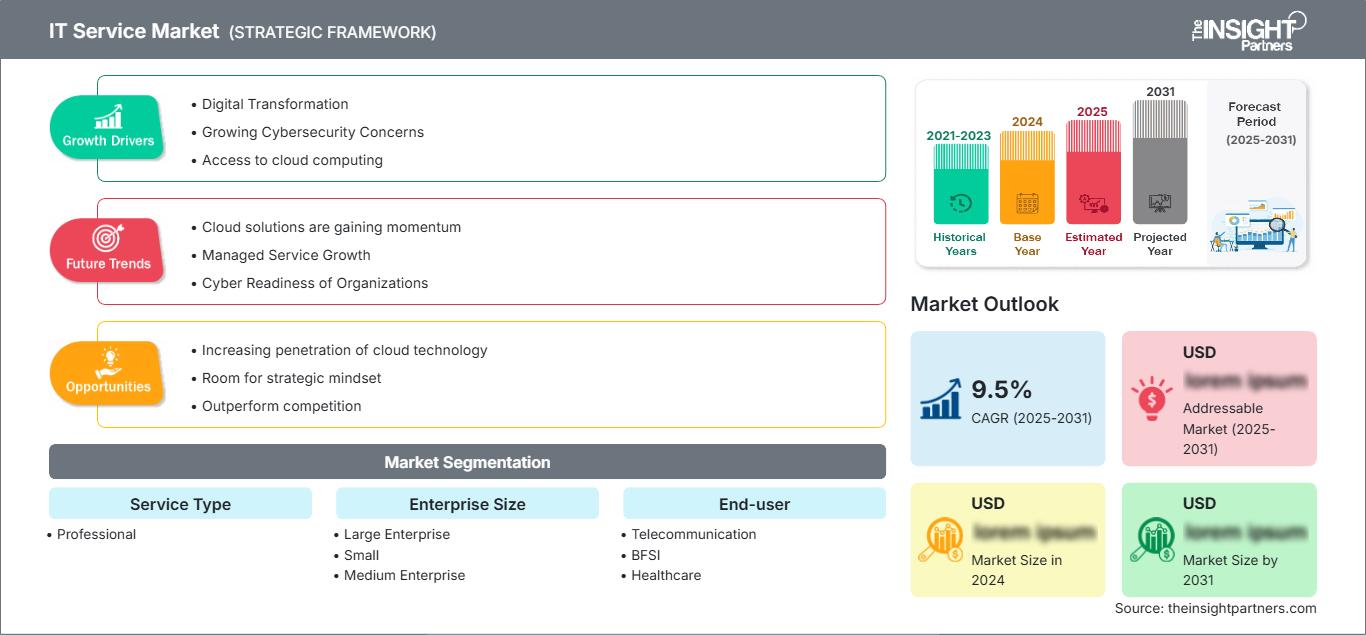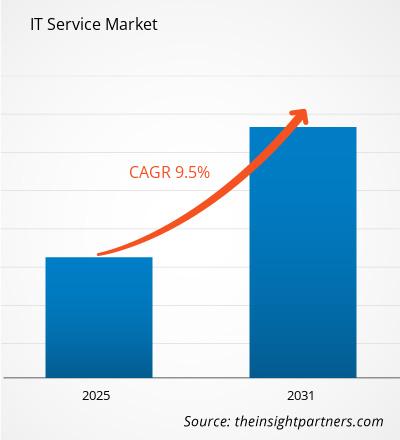The IT Service Market is expected to register a CAGR of 9.5% from 2025 to 2031, with a market size expanding from US$ XX million in 2024 to US$ XX Million by 2031.
The IT Service Market report is sub-categorized: by Service Type, by Enterprise Size, by End-user and by Geography. The regional analysis encompasses various markets in different leading countries. The valuation of the market is provided in US dollars (US$) for all the segmental analyses mentioned above to give a comprehensive picture and trend of the market.
Purpose of the Report
The report IT Service Market by The Insight Partners aims to describe the present landscape and future growth, top driving factors, challenges, and opportunities. This will provide insights to various business stakeholders, such as:
- Technology Providers/Manufacturers: To understand the evolving market dynamics and know the potential growth opportunities, enabling them to make informed strategic decisions.
- Investors: To conduct a comprehensive trend analysis regarding the market growth rate, market financial projections, and opportunities that exist across the value chain.
- Regulatory bodies: To regulate policies and police activities in the market with the aim of minimizing abuse, preserving investor trust and confidence, and upholding the integrity and stability of the market.
IT Service Market Segmentation
Service Type
- Professional
Enterprise Size
- Large Enterprise
- Small
- Medium Enterprise
End-user
- Telecommunication
- BFSI
- Healthcare
- Retail
- Manufacturing
- Government
- others
Geography
- North America
- Europe
- Asia-Pacific
- South and Central America
- Middle East and Africa
You will get customization on any report - free of charge - including parts of this report, or country-level analysis, Excel Data pack, as well as avail great offers and discounts for start-ups & universities
IT Service Market: Strategic Insights

-
Get Top Key Market Trends of this report.This FREE sample will include data analysis, ranging from market trends to estimates and forecasts.
IT Service Market Growth Drivers
- Digital Transformation: Initiatives of Digital Transformation will modernize the uptake of digital technologies by organizations quite fast; hence, IT services that support digital transformation will be in high demand. Organizations are leveraging digital tools and technology, but while integrating they face challenges with existing business procedures. This generates demand for IT services that integrate everything effectively. Moreover, IT service providers play a crucial role in facilitating this integration. With the increase in digitalization, consumer expectations also increased. Services that support personalized experiences, and responsive customer support are an essential part of this transformation.
- Growing Cybersecurity Concerns: Every operational organization now prioritizes IT security due to the frequency of cyber threats and data breaches. Investments in cybersecurity services have increased as a result, increasing demand for highly qualified IT service providers.
- Access to cloud computing: Cloud computing has been one of the prime factors for the growth of IT services, as organizations today are relying on cloud-based solutions to make business operations scalable and affordable. Each of these requires IT services.
IT Service Market Future Trends
- Cloud solutions are gaining momentum: This leads to, consequently, an upsurge in demand for cloud-related IT services management, migration, and support. Thus, this reflects the great potential for the investors within an IT service market. Companies, moving forward in flexible and cost-effective IT services, are showing demand and are expected to remain dominant in the anticipation for cloud infrastructure. Driving this trend is majorly by the demand from businesses to adapt to random changes. Companies are moving to multi-cloud and hybrid cloud.
- Managed Service Growth: The trends have gradually but surely shifted to managed services wherein organizations outsource their IT functions.
- Cyber Readiness of Organizations: Because of a growing number of cyber incidents, organizations are taking serious cybersecurity measures. IT service-providing companies, therefore, are expanding their services. MSP subscriptions: More organizations are embracing managed services programs as those offer IT support at lower cost that allows them to scale as their need. Organizations can forecast their internal budget and track their expenses easily. MSP subscription packages are likely to gain positive responses from business development teams for critical and mission-specific tasks.
IT Service Market Opportunities
- Increasing penetration of cloud technology: As of December 2023, many large enterprises aspired to have 60% of their environment in the cloud by 2025. Moreover, early detection of problems saves the cost of repair for businesses. Many IT service companies offer continued oversight and assessment to ensure seamless operations
- Room for strategic mindset: The IT service industry will need a strategic mindset to keep pace with rapid changes and adopt innovations traversing all industries. Knowing that customers are always in a state of change, is necessary for companies willing to serve their needs.
- Outperform competition: Companies need to master their capacities to outperform the competition and deliver high-quality services. Investing in companies that provide cloud migration and consulting services is a lucrative opportunity for businesses. Look for firms that offer hybrid solutions to acquire a broader market. With cyber threats, companies are investing in incident response, cyber threat detection, and complaint services seen to have growth potential.
IT Service Market Regional Insights
The regional trends and factors influencing the IT Service Market throughout the forecast period have been thoroughly explained by the analysts at The Insight Partners. This section also discusses IT Service Market segments and geography across North America, Europe, Asia Pacific, Middle East and Africa, and South and Central America.
IT Service Market Report Scope
| Report Attribute | Details |
|---|---|
| Market size in 2024 | US$ XX million |
| Market Size by 2031 | US$ XX Million |
| Global CAGR (2025 - 2031) | 9.5% |
| Historical Data | 2021-2023 |
| Forecast period | 2025-2031 |
| Segments Covered |
By Service Type
|
| Regions and Countries Covered |
North America
|
| Market leaders and key company profiles |
|
IT Service Market Players Density: Understanding Its Impact on Business Dynamics
The IT Service Market is growing rapidly, driven by increasing end-user demand due to factors such as evolving consumer preferences, technological advancements, and greater awareness of the product's benefits. As demand rises, businesses are expanding their offerings, innovating to meet consumer needs, and capitalizing on emerging trends, which further fuels market growth.

- Get the IT Service Market top key players overview
Key Selling Points
- Comprehensive Coverage: The report comprehensively covers the analysis of products, services, types, and end users of the IT Service Market, providing a holistic landscape.
- Expert Analysis: The report is compiled based on the in-depth understanding of industry experts and analysts.
- Up-to-date Information: The report assures business relevance due to its coverage of recent information and data trends.
- Customization Options: This report can be customized to cater to specific client requirements and suit the business strategies aptly.
The research report on the IT Service Market can, therefore, help spearhead the trail of decoding and understanding the industry scenario and growth prospects. Although there can be a few valid concerns, the overall benefits of this report tend to outweigh the disadvantages.
Frequently Asked Questions
What are the options available for the customization of this report?
What are the deliverable formats of the It Service market report?
Which are the leading players operating in the IT Service market?
What is the expected CAGR of the IT Service Market?
What are the driving factors impacting the IT Service Market?
What are the future trends of the IT service market?
- Historical Analysis (2 Years), Base Year, Forecast (7 Years) with CAGR
- PEST and SWOT Analysis
- Market Size Value / Volume - Global, Regional, Country
- Industry and Competitive Landscape
- Excel Dataset
Recent Reports
Testimonials
Reason to Buy
- Informed Decision-Making
- Understanding Market Dynamics
- Competitive Analysis
- Identifying Emerging Markets
- Customer Insights
- Market Forecasts
- Risk Mitigation
- Boosting Operational Efficiency
- Strategic Planning
- Investment Justification
- Tracking Industry Innovations
- Aligning with Regulatory Trends





















 Get Free Sample For
Get Free Sample For